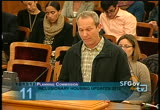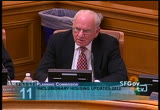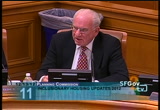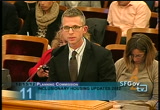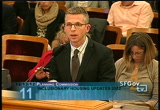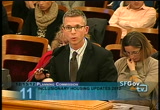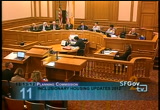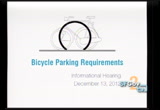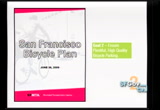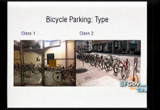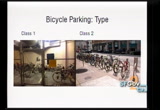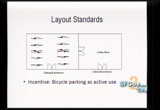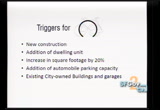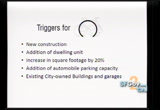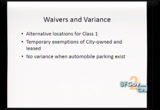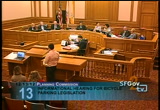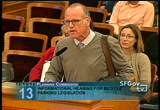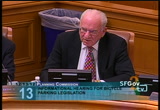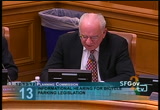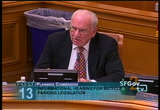tv [untitled] December 20, 2012 2:30pm-3:00pm PST
2:30 pm
producing units, bricks and mortar, permanently affordable housing and developers are rewarded for that. so we should see an increase in the number of bmrs because of that. there is also a piece of trailing legislation that will come before you presumably in the 1st quarter of next year. we think it's a smart idea to make sure that the program is as successful as possible. the idea is to allow more of a range of pricing both of the rental and for-sale, up to a cap, dealing with the low and moderate income categories and then basically vary the number of units that are required, according to the pricing. so you are still getting the same obligation in terms of cost, but you are allowing more variety of the pricing. again, smart stuff. just to conclude, the inclusionary housing program is an essential part of your
2:31 pm
housing policy and we're glad to seing that the mayor's office of housing putting in the effort and thank you folks as well. >> thank you. any additional public comment? seeing none, commissioner antonini? >> mr. cowan spoke precisely of what i brought up on a number of instances and that is why i wasn't supportive, because i wasn't really clear on levels. this level that could float in certain instances say for example you brought the ami to 120-140 percentile, but you have to produce a higher percentage because your subsidy is less. so therefore, you begin to address the middle-class, because you get a couple of city employees, particularly if they are in public safety, and they are way above the levels that would be allowed by this program.
2:32 pm
they good to try to buy something and part of the provision with prop c, particularly with public safety officials, but i think using that in general is a good system. because you can build a higher number because your subsidy is less if the income levels are higher and the prices are sold are. so i think that is very good way to approach this. i had a couple of questions on some of these things brought up. i understand the rate stabilization, but in fairness to the renter, but i didn't know that i guess bmr units the owners of those were the city? i'm not sure who it is. i guess it would be the project that they are in, are still allowed to raise annually .5% of whatever allowed under rent stabilization, is that correct? >> you are talking about bmr rental? >> yes, for bmr rental units.
2:33 pm
>> the increase in represent would be based on the pricing formula related to increases in ami. so it's outside of the city's rent stabilization program. it's not related to that. >> even for a tenant, the same tenant? >> that is correct. what this clarifis is that an owner would not be able to "bank" those increases. so if didn't raise your rent in the first year, the second year and the third year, but came back in the fourth year and wanted to collect up those incremental increases, you would not be able to do that in this case. >> as along as these increases are made readily accessible to the owners of these units, so they know what each year is and they are reminded this is the
2:34 pm
case. because usually they are such very small amounts that even banking them doesn't end up being that big a percentage increase, but it's important that they know about it. your principle -- the offsite has to have final completion of certificate before the principal is allowed. that makes a lot of sense. the affordable sros, i thought all sros were essentially affordable, but they are privately-owned and they could be at any price. i am not quite sure what you are doing with that one. >> it's really to establish a category of pricing for this unit type. where one did not previously exist. and so while we had pricing mechanisms for studio, one-bedroom, two-bedroom and three-bedroom as we see some
2:35 pm
privately developed market-rate sro-buildings, the studio pricing was not the appropriate pricing level to apply to this building typography. >> and below the size of the studio and you have to price those a little differently. >> that is exactly right. >> and you mentioned a higher income would be allowed under certain circumstances for people to qualify. and i'm not quite sure what the circumstances would be. that is one the changes. >> so what we have seen is that a couple different situations. one is our current pricing mechanism and ami qualification formulas are very tight. meaning that a unit that is going to be sold at 90% ami,
2:36 pm
the eligible applicants also need to make 90% ami or below income. so it's a 1:1 match between the pricing the unit and the eligible income level. and given how the pricing works, you really have to be at 89% ami for you to be able to afford the mortgage payment. you have to be credit worthy and have the required down payment. so we have seen cases where a pool of applicants is so restricted given the tight alignment between pricing and eligibility that we wanted to provide the eligibility for bmr units to be priced still at 90% ami, but the income eligibility extended up. so it provides a bigger pool of applicants and allows us to --
2:37 pm
if facilitates the sale of the units more quickly. this was the good-faith effort line after a period of six months, units are not able to be sold. and what this allows us is under certain circumstances to grant the ability for those re-sale units to be eligible to people for up to 20% above the ami level. it doesn't change the pricing, but gives us flexibility. >> i think that is right. because if someone is at 89 and right on the line and their income falls a little, they might have trouble making the payments. so it sounds like most of these things make a lot of sense. thanks a lot. >> commissioner wu. >> i want to thank staff for
2:38 pm
working so hard on this and thank you mr. cowan for coming out. i wish we had a packed wrong. i know it's lengthy and hard to understand, but getting tot details is really what makes this city special and we should by proud to be the leader for inclusionary housing. i would move to approve with the amendments proposed by moe and planning department staff and reflect the date of the ordinance. >> second that. >> on that motion commissioners to approve with modifications (roll call ) so
2:39 pm
moved commissioners that passes unanimously 7-0. item 12 has been continued which places you on item 13. >> good afternoon planning commissioners, planning department staff. the item before you today is an informational hearing on bicycle parking legislation. on august 9th, 2012 this commission approved initiation legislation and we talked with san francisco bike coalition,
2:40 pm
boma san francisco building as the association, union square ccd and real estate department and we received comments from many of the stakeholders. staff also researched on best practices in comparable cities. we looked at portland, vancouver, new york, and also national doubt data from the association of pedestrian and bicycles. based on research, we have made some changes. i will first briefly discuss the impetus behind this legislation and next summarize the existing bicycle parking requirements in the planning code and discuss the ordinance in detail. i want to acknowledge sfmta, who is here, if you have any
2:41 pm
questions. bicycle ridership has significantly increased in san francisco over the past few years. sfmta's annual count shows ridership has more than doubled since 2006. this report also estimated over 75,000 daily bike commutes in san francisco. with all of that ridership, the city has only 3,000 bike racks on the sidewalks. it requires better infrastructure, including bicycle parking. the san francisco bike plan was adopted in 2009, a collaboration between board of mta and the planning department. san francisco bike plan is an implementation arm for our general plan and this calls for plentiful and high-quality parking as one ever of its
2:42 pm
goals. first adopted in 1996 and at that time the requirements were only applied to city-owned and leased buildings. the requirements were expanded on basis to city-owned and privately-owned garages in 1998 and to commercial and industrial uses in 2001 and residential uses in 2005 and hotel uses most recently in 2012. now i'm going to look at how our proposal would update the requirements. this proposal would include several requirements based on two bicycle typing types, class 1 and class 2 class 1 bicycle
2:43 pm
parking is secured, indoor parking targeted for long-term use usually by residents or employees. class 2 targeted short-term use, usually for visitors and can be located indoor or outdoor. requirements would require calibrating parking requirements based on the characteristic of use. for example, office uses will have more employees than visitors, than the requirement for class 1 will be higher. for personal services such as a gym, there would be more visitors and employees and class 2 requirements would be higher. our proposal would overall increase bicycle parking requirements. forresidential uses, existing requirements are one per two units. which is really low, compared to comparable cities and contemporary green standards.
2:44 pm
small projects of four units are less would not be required to provide racks. they just need to provide sufficient space for bicycles. for larger buildings over 100, the second box, the requirements will be sliding scale. so for any units over 100, the requirements would be 1:4 units. so for example, a 200-unit residential building will require 125 bicycle parking spaces. and also there will be class 2 requirements for projects -- residential probings projects which are geared towards visitors and guests.
2:45 pm
our proposal would better align these types defined for bicycle parking with other requirements such as car parking and grouped based on trip generation types and volume. so the requirements, there are only use types under commercial and that will change to more detailed categories. such as retail sales, personal services and restaurants, light manufacturing and so forth. in order to prescribe the amounts of bicycle parking for each of these unit categories, staff compared each use category to comparable cities and overall, we thought to get bicycle parking for 5% of trips generated for each use. here are a few examples of before-and-after requirements. so for example, for a grocery store of 30,000-square-feet, which is the size of like a
2:46 pm
whole foods, right now class 1 or 2 combined -- but the new requirements will make it to full class 1 and 12 class 2 spaces. for a restaurant of 2500-square-feet, existing requirements doesn't require any bicycle parking. and our proposal will require 2 class 1 and 3 class 2. and the same with medical clinics and office buildings there will be increases. and also a separation of class 1 and class 2. our proposal guides the location of bicycle parking for indoor spaces and we would
2:47 pm
incentivize bicycle parking as an active use. bicycle parking on the ground floor is considered active year so long as the space as direct access from the sidewalk and visible also from the sidewalk. and it would also limit the combined lobby and bicycle space to no more than 40' or 25% of the lot frontage. our proposal will also include a no zoning administrator bulletin, to provide further specifications for the design and layout of bicycle parking. this is again an example that the department worked closely with sfmta to create really simple diagrams that depict these requirements. an example here is showing the required distance between racks and also the distance to a curb
2:48 pm
or wall. another incentive offered is a line conversion of auto parking to bike parking. existing bike parking requirements also allow such conversion, for class 1 parking is required. however, this provision in the code does not specify any details and therefore remains unclear and really hard to implement. our proposal would provide specific ratios to convert an auto parking to class 1 or class 2 bicycle parking spaces and at minimum, each auto parking space can be replaced with seven bike parking spaces of any combination. existing buildings also could voluntarily convert their auto parking space to bike parking and i want to highlight that this is -- this requirement would just allow project
2:49 pm
sponsor and property owners to convert auto parking to bicycle parking and they are not mandating such conversion. also there is a provision for an in-lieu fee to satisfy parts of class 2 bicycle parking requirements. and this ordinance will create a bicycle parking fund. sfmta would administer this fund and they will use the moneys to provide bicycle parking on public right-of-ways that have deficiencis in bicycle parking. there is also clear triggers that are established for bicycle parking requirements. bike parking would be needed for new construction, addition of 20% or more-square-footage and increase in car parking capacity. the city believes it's
2:50 pm
important to be the lead in green building design and therefore, all existing city-owned and leased buildings and garages would be subject to these new requirements. our proposal would also interact with other existing city laws. in march, 2012, legislation sponsored by supervisor avalos was passed that amended the environment code to require owners of existing commercial buildings to allow their tenants to bring their bikes in. alternatively, if owners don't want to allow their tenants to bring their bikes in, they are required by the environment code to provide bicycle parking space. our proposed ordinance allows such attorneys owners to comply with the code. any property that has not complied with environment code
2:51 pm
by august, 1 2013 deadline they will be out of compliance and if this ordinance is adopted they would have to comply with the updated bicycle parking requirements as defined in this ordinance. finally, the zoning administrator would also be able to modify, waive and provide variances for bicycle parking under certain circumstances. in cases where off-street car parking is not provided. overall, no variance would be given when automobile parking exists, or proposed in the building. this concludes my presentation. we are pleased to present this to you today. this ordinance would help the city to satisfy the increasing need for bicycle infrastructure.
2:52 pm
sufficient bike parking would help make biking a convenient choice for commuting. >> we have receive some support and comments from the san francisco real estate department and san francisco bike coalition sfmta. we looking forward to comments from you toble possibly have an adoption hearing in january. >> is there any public comment on this item?
2:53 pm
>> we look forward to continuing this conversation and moving forward with this for a vote in january. the current bicycle parking standards adopted in 2005 were sufficient at the time, but since then we have seen as was specified, seen an increase of 71% ridership since that time in 2005. with the san francisco city council and the board of supervisors adopting a 20% of trips by bike, by 2020, as a citywide goal, clearly these bike parking amendments are really great way to help show the ability for someone to be able to ride to and from work, play, shopping and whatever it might be. bicycle parking is obviously a very important component to the bicycle network besides simply bike lanes.
2:54 pm
with estimates of approximately 86,000 bicycle trips each day and as you heard there are approximately only 3,000 sidewalk racks currently in existence. these people obviously need a safe and convenient place to park their bikes. so i look forward to the discussion. >> thank you. >> good afternoon, commissioners. tim colin on behalf of the housing action coalition. we are very pleased to support this. you should know a senior staff person on the bicycle coalition joined our board, and the bicycle coalition is regularly attendance when' review and analyze and discuss projects. the view of increasing bicycles is a strong part of what we look at when we see projects. when i have noticed over the years that i have been there, is how many more people in our community are using bikes as they preferred way to get
2:55 pm
around? and how much more support has developed in our community around this? this is a sensible, logical advance in urban policy and deserves your support. we strongly endorse where this is going. thank you. >> any additional public comment on this item? seeing none, commissioner antonini? >> i have a few questions on some of the items. you mentioned an increase of 20% in-square-footage or one more additional dwelling units that would trigger the requirement, would that be for a private residence too? if you just added 20% to your residence? >> so any building? >> but it could be a private residence or a private home? >> yes. >> okay. i don't quite understand that. >> maybe if you could describe the parking requirements for a
2:56 pm
small residential building, it's just garage space that is sufficient. that is all. >> for buildings of four units or less, sorry, for buildings less than four units, there won't need to be any rocks. it just needs to be sufficient space for bikes in their garage or any other storage space. for buildings of four or more units there are requirements for one bicycle space for each unit. and then any building that adds another unit or adds 20% of-square-footage to the building will be subject to the new requirements. >> okay. my second question is who makes the decision? i saw an example of the street parking being taken away and replaced by
2:57 pm
bicycle parking. who makes that kind of decision? >> i think -- >> my name is heath maddox, manager of the bicycle program. the picture you saw was an example of on-street bicycle parking. we have our own bicycle parking program and install bike racks and we have been putting racks on the streets that we call "bicycle parking corrals." the picture may have been a little misleading because i don't think on-street bicycle parking would be an appropriate response for any of these requirements in the planning code.
2:58 pm
>> from what i am hearing from you it's voluntary, because it's hard enough to park in some of the neighborhoods, but you saying most of the time you try to do it on the sidewalk if you can? >> we do it increasingly, there is so much demand for bicycle parking and sidewalks are narrow and there is a lot of other uses, that there is no room on the sidewalk and businesses are increasingly realizing what is important to them is to increase traffic and customers to their business. and that you get more people there by bicycle than by car . >> the other thing, i don't know if you can answer that, but i talked about some of the places -- i don't know if it's class 1 or class 2, but restaurants are often very small and very tight as it is. and i doubt there would be room inside many restaurants to be able to put a class 1 parking space. and i also questioned medical
2:59 pm
offices. many medical offices are very small and they are within buildings that have a lot of offices there. how would you handle that? would you make the whole building do it or each individual owner of a medical office have to provide their own parking space? >> the requirements are for new projects. so for example, when there is a new restaurant, the class 1 requirement is for every 7500-square-feet of restaurant, there will be class 1 bicycle parking. if it's less than 7500, then class 1 won't be required. but class 2 will be in the public right-of-way, so they don't have to use their own space for that. the same wit
74 Views
IN COLLECTIONS
SFGTV2: San Francisco Government Television Television Archive
Television Archive  Television Archive News Search Service
Television Archive News Search Service 
Uploaded by TV Archive on

 Live Music Archive
Live Music Archive Librivox Free Audio
Librivox Free Audio Metropolitan Museum
Metropolitan Museum Cleveland Museum of Art
Cleveland Museum of Art Internet Arcade
Internet Arcade Console Living Room
Console Living Room Books to Borrow
Books to Borrow Open Library
Open Library TV News
TV News Understanding 9/11
Understanding 9/11